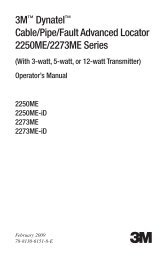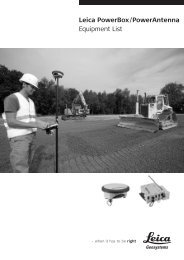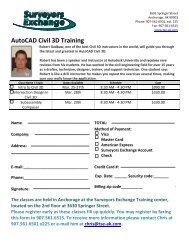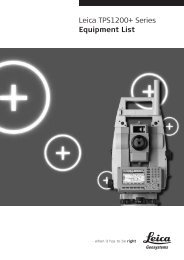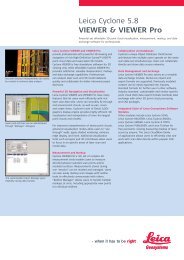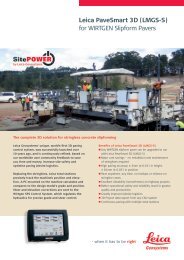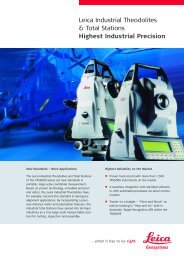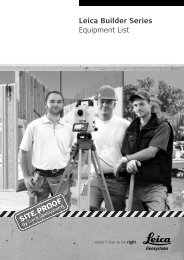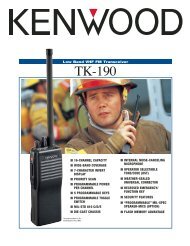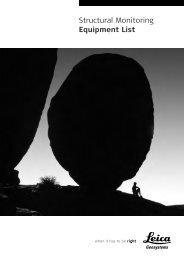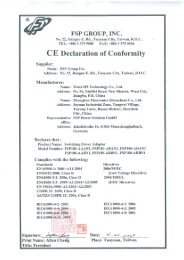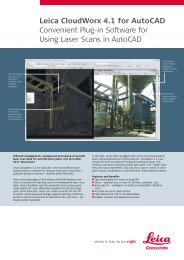Metrology Assisted Assembly & Automated Inspection - Leica ...
Metrology Assisted Assembly & Automated Inspection - Leica ...
Metrology Assisted Assembly & Automated Inspection - Leica ...
Create successful ePaper yourself
Turn your PDF publications into a flip-book with our unique Google optimized e-Paper software.
<strong>Leica</strong> Geosystems Laser Tracker<strong>Metrology</strong> <strong>Assisted</strong> <strong>Assembly</strong>& <strong>Automated</strong> <strong>Inspection</strong>
Table of ContentsIntroduction 3Automation Integration Experiences 4- Existing Automation Integration SuccessA “Front End” Software Independent Solution 6- Software with an Advanced Internal Scripting language- Software with an SDK based External Scripting LanguageApplication Specific Measurement Processes 8- <strong>Automated</strong> <strong>Assembly</strong> using 3D point networksand the <strong>Leica</strong> Geosystems 6DoF MAP System- An internal and external Measurement Process Managerin one piece of software- <strong>Automated</strong> non-contact inspection utilizing 6DoF technology- Extension of <strong>Leica</strong> T-Mac by non-contact sensor- Extensions of <strong>Leica</strong> T-Mac by a touch trigger sensor- Multi-sided Machine Control Probe- <strong>Leica</strong> T-Probe / <strong>Leica</strong> T-Mac integrated line Scanner
IntroductionThe <strong>Metrology</strong> division of <strong>Leica</strong> Geosystems is part ofHexagon <strong>Metrology</strong>. The core measurement sensorshas been keepen with the same level of qualitythat is expected from the <strong>Leica</strong> Geosystems name,but have been able to leverage the many strengthsof the new Hexagon <strong>Metrology</strong> organization. One ofthese strengths is the addition of the EMS PC-DMISmeasurement software. This software package gives<strong>Leica</strong> Geosystems far more power and functionalityfor advanced automation. Not only are we now capableto satisfy many of the automation tasks froma technical side, we are also far more prepared fromthe commercial side. Hexagon <strong>Metrology</strong> now has therequired competences to be able to handle many ofthese major integration projects. The Hexagon CommercialOrganisations (or COs) have literally hundreds ofsoftware integrators around the world, and an installedbase of more than 30,000 seats of PC-DMIS. The COsare also responsible for the full Hexagon <strong>Metrology</strong>product portfolio including: articulated arms, CMMs,vision machines, and a full line of precision tools, anyof which Hexagon would be glad to support during anintegration project. However, the primary focus of thisdocument will be based on the <strong>Leica</strong> Absolute Trackerand our associated 6DoF products. We will detail twodifferent concepts that will allow both the front-end(Human Machine Interface) and the backend (Analysisand Database Management) of the metrology softwareto be completely independent of our final hardware solution.This will allow each individual process to use themost appropriate measurement software available. Thiscould be PC-DMIS, Spatial Analyser, Metrologic, BuildIt, PolyWorks, or something completely custom made.We don’t intend to force the customer or the integratorto use a software solution that is outside of their scope,so these concepts aim to simplify the integration of ourhardware solutions.Duncan Redgewell, General Manager <strong>Leica</strong> Geosystems<strong>Metrology</strong> ProductsNow with support of our extended Hexagon <strong>Metrology</strong>brands, we can offer the strength and knowledge of aworld-class automation infrastructure like PC-DMIS withhundreds of EMS PC-DMIS software integrators aroundthe world, and a full portfolio of additional metrologyhardware, like articulated arms and CMMs. In additionto this we have recently created an Automation and Integrationgroup within <strong>Leica</strong> Geosystems natively. Thisgroup of dedicated application engineers and softwareprogrammers have the ideal combination of softwareand programming expertise, mixed with years of portablemeasurement experience to be able to assist with,or even create full turn key customized software solutions.With our unique proven technologies, extensivemetrology background, and creative software solutions,we are constantly pushing the envelope of what can bedone in the field of <strong>Metrology</strong> <strong>Assisted</strong> <strong>Assembly</strong> and<strong>Automated</strong> <strong>Inspection</strong>.Introduction 3
Bremen A 400M, Sec.600 assembly automated system:1 LTD640 emScon 2.3Bremen A 400M, Sec.700 assembly automated system;2 LTD640 emScon 2.3Bremen A 400M, Sec. 850 assembly automated system:2 LTD640 emScon 2.3Bremen A 400M, Sec.800 assembly automated system:2 LTD640 emScon 2.3Hamburg Hatrack A 380 assembly partly automatedsystem: 1 LTD600 Axyz/PAMHamburg Hatrack LR (A330/340) assembly partly automatedsystem: 1 LTD500 Axyz/PAMHamburg RMK assembly automated system:1 LTD600, 1LTD800 emScon 1.5.3Hamburg Sec. 13 assembly automated system:2 LTD600 emScon 1.5.3Hamburg Sec. 18.1 assembly automated system:2 LTD500 emScon 1.5.2Hamburg Sec. 18.3 assembly automated system:1 LTD500 emScon 1.5.3Hamburg Megaschale assembly automated system:2 LTD500 emScon 1.5.2Hamburg MCA (Ass. 18.1, 18.3,19) assembly automatedsystem: 2 LTD600 Axyz/PAMStade VS A380 assembly & part inspection automatedsystem: 1 LTD640 emScon 2.0Stade VS A400M assembly & part inspection automatedsystem: 1 LTD640 emScon 2.3EADSGetafe Eurofighter assemby fuselage and Integrationautomated system: 2 LTD600 emScon 1.5.3Sevilla FAL A400M 2 x assemby wing to body automatedsystem: 2 x 2LTD640 emScon 2.0Sevilla FAL A400M sub- assembly automated system:2 LTD640 emScon 2.0Sevilla FAL A400M Final assembly and part inspectionautomated system: 2 LTD640 emScon 2.3CERN LHC<strong>Inspection</strong> and alignement of magnets automatedsystem: 19 LTD500 Axyz Ole /DGMABB RoboticsManufacturing robots calibration robots to get absoluteaccuracy automated system: 1 LTD500 Axyz/ ScriptManufacturing robots calibration robots to get absoluteaccuracy partly automated system: 1 TDA5005 Axyz/ScriptBAEWarton Eurofighter assemby fuselage and Integrationautomated system: 2 LTD500 emScon 1.5.3Rolls Royce3 BSM auto inspection partly automated system:LTD840/<strong>Leica</strong> T-Probe emScon 2.3Westland HelicoptersR101 Airframe structural test automated system:2 LTD640 emScon 2.0Boeing Renton WAB737 Wing to Body Join automated movement of wingto body: 5 LTD500 Axyz/Visual BasicBoeing St Louis MOFA-18 Fuseage Join automated movement of fuseages1 LTD500 Axyz/Visual BasicGulfstreamWing assembly automated movement of wing section:1 LTD500 Axyz/Visual BasicBerkley LabParticle Accelerator Survey of Magnets Survey andalign magnets: 1 LTD800 Axyz/PAMAirbus SpainGetafe A380 Sec. 19 manufacturing & assembly automatedsystem: 1 LTD640 emScon 2.3Getafe A320 manufacturing & assembly automatedsystem: 1 LTD640 emScon 1.5.3P.Real A380 HTTP assembly automated system:1 LTD640 emScon 2.3Boeing/Tulsa OKB777 <strong>Inspection</strong> floor rails by Part no: 1 LTD Axyz/PAMADC EngineeringHelicopter <strong>Inspection</strong>/Modification Integrated measurement/document:1 LTD emScon/Visual BasicAutomation Integration Experiences 5
A “Front End” Software Independent SolutionSoftware with an Advanced Internal ScriptinglanguageSoftware with an SDK based External ScriptinglanguageThere are two main concepts on how to integrate ametrology based software solution into an automatedassembly cell. The first and most common, is to usethe metrology software as the Measurement ProcessManager. In this scenario the metrology software isresponsible to interface with all of the needed productsi.e. measurement sensors, databases, positioningsystems, etc…The second concept is to use an independent MeasurementProcess Manager that wraps around the actualmeasurement software. In this configuration the measurementsoftware package doesn’t need to be able tointerface to every required device. The measurementsoftware can talk to the measurement sensor(s), whilethe Measurement Process Manager is responsible forthe communication between the measurement software,external positioning systems, databases, etc…Measurement SoftwareGraphical User InterfaceApplication ProcessManagerMeasurement ProcessManagerTriggerMeasurementDatum PointsDev.<strong>Assembly</strong> Process ManagerJig- and Tool Controller(Actuators)Measurement Process ManagerMeasurementSoftwareGraphical User InterfaceApplication Process ManagerTriggerMeasurement<strong>Assembly</strong> Process ManagerJig- and Tool Controller(Actuators)Tracker 1NominalActualDatum PointsDev.Tracker 2Tracker xDatabaseTracker 1NominalActualTracker 2Tracker xDatabaseThis process has been used on a number of automationinstallations due to its ease of integration. In this setupthe <strong>Assembly</strong> Process Manager provides the correctionparameters from measurement software to the jig andtool controllers (actuators). In this case, the measurementsoftware package needs to be very advanced,and must include native interfaces to any of the controldevices, and have a highly customizable internal macrolanguage. An example of this type of solution would beeither Spatial Analyzer, or Metrologic. We will not gointo too much detail on this type of integration sinceit is well accepted in most industries. Currently wehave interfaces to an extensive list of these advancedmetrology packages, all of which maintain state of theart interfaces to our hardware through our embeddedsystem control (emScon) SDK.The advantages of this type of solution have beenclearly identified on some of our most recent integrationprojects. The Measurement Process Manager, orMPM, controls all of the functions related to the actualmetrology measurements, and can then be controlledby any independent Application Process Manager, orintegrated Human Machine Interface. This could bedemonstrated in a recent project where multiple LaserTrackers were bundled together, oriented to a singlestation location, and then controlled by a very simpleVisualbasic application. This not only allows you toseparate the software front end, but also (as shown inthis example) allows you to then send the measuredresults to any addition software package for furtheranalysis.6 A “Front End” Software Independant Solution
Let’s look at how this concept could be used in a standardmeasurement process as it would relate to a 3Dpoint based wing to body assembly. In the first threesteps listed below, the Laser Tracker needs to be initialized,the nominal points need to be read in from theglobal database, and the reference points need to bemeasured. In the last three steps the multiple stationsare bundled together using the reference points andare then aligned directly to the fuselage. Once the stationsare aligned to each other and to the fuselage, thepoints on the wings can be measured sequentially. TheMPM takes Page 7 of 15 control of this complete processby allowing all of the measurements to be stored,bundled, and best-fit with only a handful of commandsrequired by the controlling application. This removesthe need for the integration company to have an indepthknowledge of metrology to be able to achieve thedesired results very quickly through a simple SDK.Step 1: Initialize Measurement ProcessStep 2: Read in Nominal from DatabaseStep 3: Mesure Reference PointsStep 4: Bundle StationsStep 5: Align Stations Setup to FuselageStep 6: Mesure Actual Wing PositionNow let’s take this process a step further. Traditionallythe Laser Tracker measures a series of fixed pointson the wing and body respectively; the measurementsoftware (e.g. Spatial Analyzer) then calculates themovement deltas and writes the results to a centraldatabase. The <strong>Assembly</strong> Process Manager can readthose values and move the actuators incrementally inan iterative process between measuring, moving, stop-ping, measuring, moving, stopping, etc… until the wingis in its final assembly location. The iterations requirethe object to be stationary while being measured andthis can be a tedious and time consuming process. Tospeed this process up we could use the <strong>Leica</strong> Geosystems6DoF MAP System that allows the wing to betracked in real-time with an automated feedback loopdirectly to the <strong>Assembly</strong> Process Manager from theMPM.YesStep 1: Initialize Measurement ProcessStep 2: Read in Nominal from DatabaseStep 9: Measure T-Mac Position Calc deviation of actual Datum Point positionAbove specified Safety GapThe MPM would not only control all of the measurementsand their mathematics, but would also communicatedirectly with the <strong>Assembly</strong> Process Manager forthe control loop between the 6DoF measurements andthe actuators. This would allow for a system integratorto use the core measurement technology in the mostbeneficial way, without the need to constantly worryabout whether the Human Machine Interface or theanalysis package can control all of the requested functionsin the measurement hardware.Send Deviations to<strong>Assembly</strong> ProcessA “Front End” Software Independant Solution 7
Application Specific Measurement Processes<strong>Automated</strong> <strong>Assembly</strong> using 3D point networks andthe <strong>Leica</strong> Geosystems 6DoF MAP SystemAs we have already started to describe some ideasregarding wing to body stations lets continue on thistopic. We will not spend too much time on the 3Dpoint network process for these automated assemblyprocesses due to the fact that they are fairly well knownand accepted, as well as the fact that we have alreadydetailed the two “front end” control software possibilities.Instead, we will describe a hybrid combinationof 3D point based assembly with the addition of 6DoFreal-time tracking that creates the <strong>Leica</strong> Geosystems<strong>Metrology</strong> <strong>Assisted</strong> Positioning, or MAP system. Theproposed <strong>Leica</strong> Geosystems 6Dof MAP system couldcut the standard MAA joining times by as much as athird, or at least a quarter. In a standard application aLaser Tracker would have to measure a network of between6 – 8 points on the wing, plus a series of pointson the body. This process would typically take between30 to 40 seconds to complete. However, it is not themeasurement time that slows this process down. Thelimiting factor is the time that it takes to move the Jigsand re-measure the parts in an iterative process.If we concentrate on a single wing (above) then thetime required to move this wing into position couldtake up to 45 minutes for just the measurements. Thisis assuming roughly 5 seconds per point for positioningand measurement of the Laser Tracker, and between 10– 15 iterations to bring the wing into the final alignmentposition. In comparison, using the same wing, but thistime rather than calculating the positioning deltas froma network of points, we’ll use the <strong>Leica</strong> Geosystems6DoF MAP System to track the wing in real-time. The6DoF MAP system consists of a <strong>Leica</strong> T-Mac in combinationwith a <strong>Leica</strong> Absolute Laser Tracker and T-Cam.The <strong>Leica</strong> T-Mac is attached to the part that needs to bealigned (in this case the wing), and the 6DoF deltas arefed back in real-time directly to the wing positioners.The <strong>Leica</strong> T-Mac has the same 3D positional uncertaintyof a standard Laser Tracker measurement, but alsogeneratesPage 9 of 15 pitch, roll, and yaw angles. The 2 Sigmaangular uncertainty is 0.01° so long as the <strong>Leica</strong> T-Macis mounted no more than 6 meters from any edge ofthe mating surface, the achievable accuracy along thissurface is equal to about 1.0mm (where Δb = Sin * Radius).This allows for a very flexible setup process wherethe <strong>Leica</strong> T-Mac could even be placed meters above thewing for extremely easy line of sight requirements.◄ ►► ◄>2m>2mThe communication from the <strong>Leica</strong> T-Mac position tothe wing positioners is a direct feedback loop to keepthe data latency as low as possible. This helps to positionthe wing with the maximum amount of time savings.In order to guarantee that the wing never touchesthe body during the MAP process, a positive gap of5mm should be maintained. This is roughly equal to adoubling of the 6H uncertainty of the <strong>Leica</strong> T-Mac rotationangles at these distances (e.g. 6 meters).Once the <strong>Leica</strong> Geosystems 6DoF MAP system finishes,and the wing is within 5mm of its final location, thenthe standard process of measuring the fixed reflectorsand calculating the best-fit positioning for the finallocation should start. This process should run as itdoes with the other Aerospace FAL processes that arealready proven out. Whether the process is controlledfrom an external Application Process Manager or froman integrated metrology package is inconsequential toour overall solution. The main differences would be thatif it is implemented in an integrated metrology package(e.g. Spatial Analyzer, or Metrologic), all parts ofthe communication would need to be integrated by thismetrology software. If however it is implemented asa measurement process in the Measurement ProcessManager it could use the functionality that is integratedin the MPM (e.g. transformations, bundle, etc…) andcommunicate directly with the <strong>Assembly</strong> Process Managerthat is controlling the wing positioners.8 Application Specific Measurement Processes
The time savings from the <strong>Leica</strong> Geosystems 6DoF Mapsystem as described above is detailed in the followingdiagram. In addition, the cost of the complete systemcan be scaled by the number of <strong>Leica</strong> T-Mac sensorsshared between all of the assembly structures. Thetrade off is obviously the speed at which the completeprocess would run. An integration with three LaserTrackers and three <strong>Leica</strong> T-Mac’s could do both of thewings, and the stabilizer simultaneously in a period ofapproximately 15 minutes, while a system with only one<strong>Leica</strong> T-Mac would take almost three times as long dueto the need to run the processes sequentially. Thesetimes only look at the estimates for the measuring anddo not take into account the times required for thepositioners to actually move the parts. For instance thisprocess in an existing installation takes approximately2.5 hours not just 45 minutes. However, the time savingsnoted above are directly proportional. It shouldalso be noted that time savings is not the only majoradvantage here.An internal and external Measurement ProcessManager in one piece of softwareIn section 3 we detailed the differences between ameasurement software that uses an internal scriptinglanguage, and an external Measurement ProcessManager that wraps around the individual hardware’smeasurement commands. However it should be notedthat it is possible for one piece of software to be able todo both.It is well understood that PC-DMIS has the ability torun advanced part programs that contain conditionallooping, and on the fly operator input to be able adaptaccordingly. But it is less well known that PC-DMIS alsohas an advanced external scripting language that allows3rd party integrators to use the basic SW packageas an MPM as previously described.Transitioning to an on-line movement could also reducethe cost of the tools and jigs. This can also translateinto using less overall reflectors, as well as less accuratepositioners since the true location would always beknown from the MAP system.Application Specific Measurement Processes 9
In this case it would be possible to replace the userinterface completely as seen in the visualbasic examplein section 3.2. PC-DMIS becomes the “brains” of themeasurement process controlling the import & exportof data, all measurement commands, bundle & alignmentmathematics, and complete database control. TheStep 1: Initialize Measurement ProcessStep 2: Read in Nominal from DatabaseStep 3: Measure Reference PointsStep 4: Bundle StationsStep 5: Align Stations Setup to FuselageStep 6: Measure Actual Wing PositionStep 7: Measure T-Mac PositionStep 8: Determince T-Mac TransformationStep 9: Measure T-Mac Position Calc deviation of actual Datum Point positionYesAbove specified Safety GapHuman Machine Interface can then be completely customizedbased on the needs of the automation projectwith a simple program that no longer needs to worryabout the actual metrology processes.We can use the <strong>Leica</strong> Geosystems 6DoF MAP systemas an example of how PC-DMIS could be used as aMeasurement Process Manager independent of the HumanMachine Interface, or the final reporting database.The workflow assembly process could look as follows,where PC-DMIS would be responsible for steps 1 – 9below. Here the 3rd party integrators Human MachineInterface only needs call step 1, and then PC-DMIScould take over the automation through step 9 until the<strong>Assembly</strong> Process Manager becomes involved to reactivatethe measurement process after the jig has moved.This loop would continue until step 11 when PC-DMISwould then send the completed measurement resultsto a global database storing the wings final location.At this point the Human Machine Interface would thenbecome integral in detailing the next steps, or statingthe process over again.Send Deviations to<strong>Assembly</strong> ProcessStep 10: Measure automated all Datum Pointson WingYesRe-measure PointsStep 11: Measure final position of DatumTransfer Points on Wing Re-measureWhite results toDatabase10 Application Specific Measurement Processes
Unlike the <strong>Leica</strong> Geosystems 6DoF MAP systemdescribed previously, where we use the 6DoF informationto correct a positioning device; we now need topre-program the robot to know how and where to scan.This needs to be programmed into the Robot ProcessManager before hand, but then once the robot programis started, the robots accuracy becomes arbitrary sincethe absolute position is measured using our 6DoFtechnology. This allows for a very accurate point cloudto be collected over an extremely large measurementvolume. The appropriate software package shouldbe selected depending on the type of analysis that isrequired by the job. For instance, if the process requiresdetailed feature extraction from the cloud of points,then a package like PC-Dmis or Metrolog may be beneficial,however if complex free form surface analysis,and flush and gap measurements need to be analyzed,then a package like Polyworks may be more applicable.No matter which way is used, at the end the customer/integrator has complete control over exactly how thedata is processed and how the results are finally reported.This process could be implemented for “hand-held”usage as well by simply removing the Robot ProcessManager, and replacing it with a trained operator. Asmentioned earlier, the robotic positioning system hasno relation to the achievable accuracy of the measurements.The robot (or operator) only needs to beaccurate enough to make sure that the measurementsare in the correct location. This same concept need notonly be applied to the <strong>Leica</strong> T-Scan, but can be appliedto a line scanner on the <strong>Leica</strong> T-Probe, or a <strong>Leica</strong> T-Macas well. It is possible to mount a <strong>Leica</strong> T-Mac like the<strong>Leica</strong> T-Scan on any robot or gantry positioning system.It can even be mounted as a sensor on a machine toolto allow for in process inspection.Take for instance a structural assembly stations, whereadditional measurement functionality could be extendedfrom a standard Laser Tracker integration. A <strong>Leica</strong>T-Mac could be added to the machine tool to allowboth positioning control, and adaptive control of theend-effector (i.e. a drilling machine). In addition to this,a laser probe could be added to this configuration to allowfor non-contact surface measurements aiding withas-built surface inspection, and or automated shimming.With one core piece of hardware (e.g. a 6DoFLaser Tracker) the entire structural assembly systemcould be controlled and automated, and again it couldbe done either with an integrated software packagelike Spatial Analyzer, or Metrologic, or with an independentApplication Process Manager, and MeasurementProcess Manager like PC-DMIS.In the above example we are using a <strong>Leica</strong> T-Mac and anon-contact laser probe attached to a robot to measurelike a standard shop floor CMM. This configurationcould also be extended to a touch trigger probe thatwould effectively turn the system into an ultra largevolume CMM with better than 0.1mm absolute accuracyover the entire volume. A robotic arm could be mountedon a translation slide that would allow it to reach Page14 of 15 across, and slide down the full length of thestructure. This would allow such a device to measuresomething as large as a meter wing fixture.Many of these <strong>Leica</strong> T-Mac/<strong>Leica</strong> T-Probe/PC-DMISautomation concepts are currently in the prototypephase within <strong>Leica</strong> Geosystems. However, due to thecomplex nature of these systems, we are looking forfurther specifications for final products from our leadcustomers, that would allow the opportunity to createcutting edge solutions based on technologically maturecore components. The specific extensions to the 6DoFhardware are detailed in the following chapters. Pleasebe aware that these solutions are only in the prototypestage, and are not yet completed final products.12 Application Specific Measurement Processes
Extension of <strong>Leica</strong> T-Mac by non-contact sensorNon-contact probes are already used together withconventional CMMs. These devices use specific triangulationsensors and deliver a trigger pulse if the laserbeam is at focus position to the surface point. This triggerpulse would be used for both 6DoF data collection,and to stop the robot movement in process.Extensions of <strong>Leica</strong> T-Mac by a touch trigger sensorTESA (part of the Hexagon <strong>Metrology</strong> group) currentlymanufactures a series of touch trigger probesdirectly related to this application. Overall the technicalenhancement would be the equivalent to thenon-contact sensor, with the only difference beingthat the trigger pulse is generated by surfacecontact and not optically.Multi-sided Machine Control ProbeInstead of just one working surface with reflectorsand marker LED’s the goal would be that a combinationof different frames (up to 4 frames with 7 LED’sper face) could be interchanged. This would create ascaleable solution with options extending from 1 to4 sides.<strong>Leica</strong> T-Probe / <strong>Leica</strong> T-Mac integrated line ScannerConnecting a line scanning device to create a lowprice solution would be useful for many standardapplications, especially in the direction of automatedsurface scanning. This type of sensor could beconnected to a <strong>Leica</strong> T-Mac, or <strong>Leica</strong> T-Probe like itexists already, or it could be used with a multi sidedMachine Control Probe as described above. The integrationshown below allows the scanning head to berotated +/- 60° around the center position for betterlaser line control.Application Specific Measurement Processes 13
Whether building the fastest car, the biggestplane, or the most precise tooling, you need exactmeasurements to improve quality and productivity.So when it has to be right, professionalstrust <strong>Leica</strong> Geosystems <strong>Metrology</strong> to help collect,analyze, and present 3-dimensional (3D) data forindustrial measurement.<strong>Leica</strong> Geosystems <strong>Metrology</strong> is best known for itsbroad array of control and industrial measurementproducts including laser trackers, Local PositioningTechnology (LPT) based systems, hand-heldscanners, 3D software and high-precision totalstations. Those who use <strong>Leica</strong> <strong>Metrology</strong> productsevery day trust them for their dependability, thevalue they deliver, and the world-class service &support that‘s second to none.Precision, reliability and service from <strong>Leica</strong>Geosystems <strong>Metrology</strong>.When it has to be right.Headquarters:<strong>Leica</strong> Geosystems<strong>Metrology</strong> ProductsMoenchmattweg 5CH-5035 UnterentfeldenSwitzerlandPhone +41 62 737 67 68Fax +41 62 737 68 68www.leica-geosystems.com/metrology© 2009 Hexagon ABAll rights reserved.



